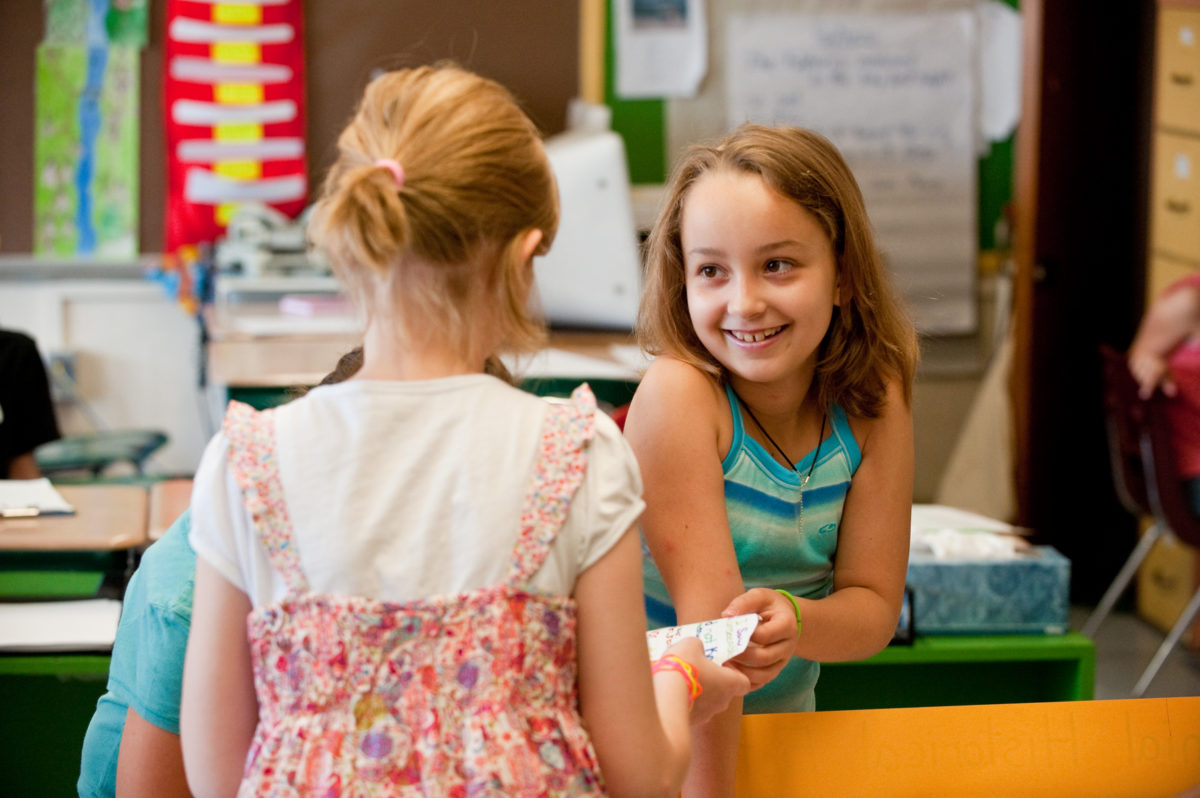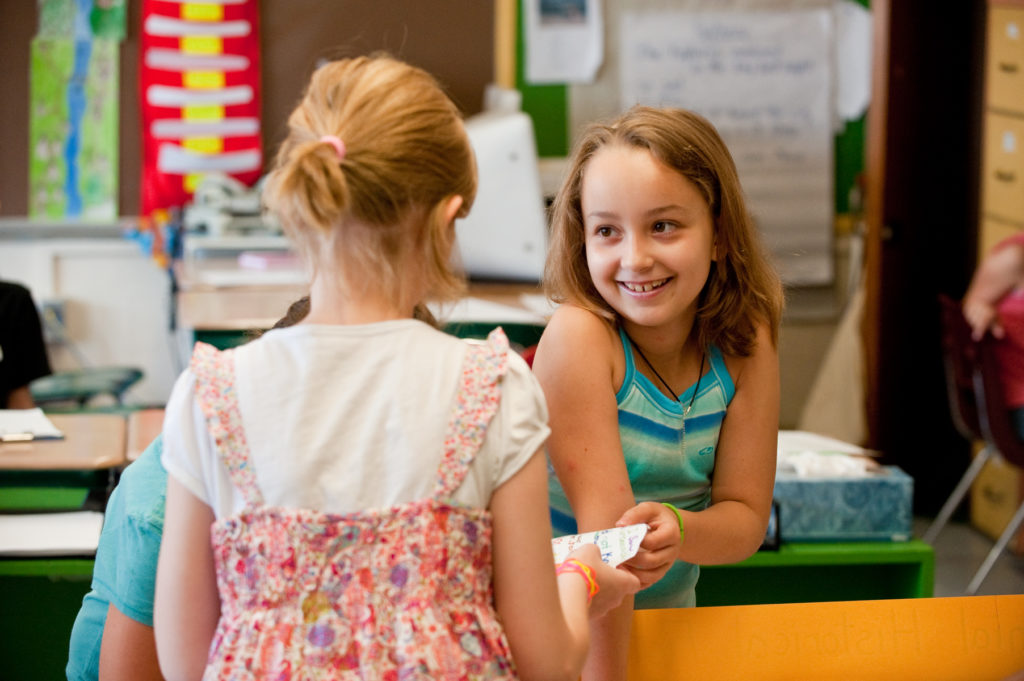Helping Students Give Effective Compliments

 Jane, a fourth grade teacher, was reviewing compliments her students had given one another on a recently completed set of projects. On sticky notes, the students had written things like “It looks like you put a lot of time and effort into your project,” “I noticed you put very detailed information,” and “Your headings are cool and because of your pictures, I know exactly how the Eiffel Tower looks.” Sound familiar? It did to Jane, who was amazed at how this student feedback resembled positive teacher language. And like reinforcing language that a teacher might use, these compliments encouraged and energized students to share even more about their topics and learning processes with one another.
Jane, a fourth grade teacher, was reviewing compliments her students had given one another on a recently completed set of projects. On sticky notes, the students had written things like “It looks like you put a lot of time and effort into your project,” “I noticed you put very detailed information,” and “Your headings are cool and because of your pictures, I know exactly how the Eiffel Tower looks.” Sound familiar? It did to Jane, who was amazed at how this student feedback resembled positive teacher language. And like reinforcing language that a teacher might use, these compliments encouraged and energized students to share even more about their topics and learning processes with one another.
Telling students what they’re doing right is one of the most powerful tools we have for helping them solidify and build on their positive behaviors and skills—and teachers aren’t the only ones who can provide this type of support. Students can also encourage each other through the effective use of giving compliments. Like all skills, giving compliments needs to be taught and practiced. It may help to start the discussion with a story or book in which one character compliments another. And teachers can use the process of Interactive Modeling to show what it looks and sounds like to give a compliment.
- To start, tell students that you’re going to demonstrate how to give a compliment, and why one might want to do so. For example, “Compliments can help people feel good about their work and build on their accomplishments. Listen as I give a compliment to one of your classmates. Then, I’m going to ask what you noticed about how it looked and sounded.”
- Demonstrate by giving a compliment to a student volunteer. “Danny, you put away all the science materials so neatly. That will help us a lot the next time we want to use them.”
- Ask students what they noticed. They might mention that you made eye contact, had a friendly facial expression, called Danny by name, and said something specific about what he had done. It may be helpful to write these observations on an anchor chart for future reference.
- Help students brainstorm what another compliment might look and sound like. “Let’s imagine that Hassan tripped, and Janelle stopped and asked if he was okay. What might a compliment to Janelle sound like?” If you feel your students are developmentally ready, you might ask a student to act out giving a compliment, with you role-playing as Janelle. You might also plan ahead with two students who can act out a previously rehearsed scenario.
- Again, ask what students noticed.
- Let students have an opportunity to practice giving compliments. This can be challenging to do on the spot, so you may want to tell students they’ll all get to practice over the next few days and follow up with them later. Students may also have an easier time connecting compliments to a fictional character from a story they’ve read, so consider having students give a compliment to a partner as if that partner is the character.
- Observe as students give one another compliments and give feedback to reinforce their efforts. “You made eye contact with each other and were very specific in your compliments!”
This process can be adapted for middle school students by using the four middle school Interactive Modeling steps:
- Describe and explain the process of giving a compliment.
- Model giving a compliment while students notice.
- Give students the opportunity to collaborate and practice giving compliments to one another, either as themselves or by having the recipient pretend to be a fictional character (as outlined in step 6 above).
- Reinforce students’ practice with immediate feedback.
It’s also important to teach students how to accept a compliment. Some students, particularly as they get older, may struggle with awkwardness or embarrassment when given a compliment, but that doesn’t mean they don’t appreciate or need them! The steps below can give everyone a framework for how to accept a compliment gracefully.
- Make eye contact.
- Thank the person in a sincere, friendly tone of voice.
Putting compliments into action in the classroom
Once students know the basic steps for giving and receiving compliments, it’s time to practice. One way to do this is through a compliment circle students prepare for throughout the day. Here’s one idea for how to do it.
- During Morning Meeting or Responsive Advisory Meeting, let students know they’ll be practicing giving a compliment later. Elementary school students can do this at the end of the day during closing circle, and middle school students can do it during future Responsive Advisory Meetings.
- Have each student draw another person’s name. This is a good time to remind them of the classroom rules, such as being kind by keeping a friendly facial expression even if they draw the name of someone they’re not close friends with.
- Set the parameters for what the compliment should focus on. For example, you might specify that the compliments should be about how people follow the classroom rules, or even one particular element of those rules, such as being kind to one another. This will help students avoid vague compliments like “You’re nice” or “You’re cool.” For example, one student might say, “Alicia, you showed good self-control by staying focused during science. That helped everybody in our group concentrate.”
- At a few points throughout the day, take a moment to remind students to watch their chosen person and think about ideas for a compliment. Is there anything they saw the person do so far that day that might be a good thing to compliment? What might they watch for in the next activities coming up? Some students may need more help thinking of a compliment, and you can support them by discussing ideas with them privately.
- When it’s time for students to give their compliments, go around the circle and have each student address the person they chose and deliver their compliment. If needed, you can write the following sentence stem to help them structure their compliments: “______, I saw you _____. That helped our class because _____.”
For elementary school students, allow enough time at closing circle (a full 10 minutes is a good idea) so that everyone has time to give and accept their compliments without feeling rushed. For middle school students, doing a compliment circle in a Friday Responsive Advisory Meeting can be an inspiring end to the week. Similarly, doing a compliment circle first thing on a Monday morning can provide a smoother, more positive transition back to the school routine.
Moving beyond the compliment circle
After students are comfortable with giving compliments, they can expand the ways they use this skill throughout the school day, inside and outside the classroom.
- Connect compliments to writing. Have students write down a compliment for someone else in the class and leave it in their cubby, on their desk, or on a sticky note on a project.
- When students are about to go to lunch or special areas, take a few moments to prepare them to give compliments to the teachers and staff in those areas. “Mr. Rose spent a lot of time cooking lunch for you today. What are some compliments you might give him when you get to the cafeteria?” After the students come back to the classroom, ask if anyone gave a compliment they would like to share.
- Before recess, prepare students to compliment one another. “Think about our rules as you head outside. What compliments might you give to people who are making recess fun for everyone by following our class rules?” After recess, ask if anyone wants to share a compliment they gave, or ask anyone who gave a compliment to give you a thumbs-up.
- Ask students to pay attention while they’re on the bus or, if they’re in middle school, while they’re in the halls as classes are changing. Can they think of compliments to give in these areas to encourage people who are making their school a safe and welcoming place?
While you may not hear every compliment students give one another, you can respond when you do hear one so that you reinforce the skill over time. And remember, compliments are good for teachers, too! Demonstrate how to accept a compliment gracefully any time a student gives you one.
When students build the skill of giving compliments, they’re able to use language to identify and affirm positive social and academic behaviors, just as teachers do with reinforcing language. This helps students play an active part in building a strong and supportive classroom community.


